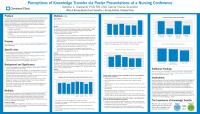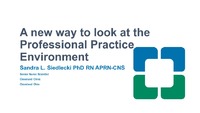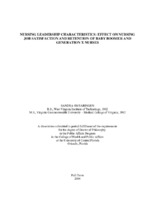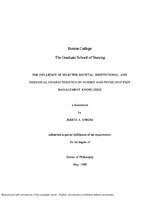| dc.contributor.author | Siedlecki, Sandra L. | en |
| dc.date.accessioned | 2016-03-17T12:50:38Z | en |
| dc.date.available | 2016-03-17T12:50:38Z | en |
| dc.date.issued | 2016-03-17 | en |
| dc.identifier | INRC15PST471 | |
| dc.identifier.uri | http://hdl.handle.net/10755/601610 | |
| dc.description | Research Congress 2015 Theme: Question Locally, Engage Regionally, Apply Globally. Held at the Puerto Rico Convention Center. | en |
| dc.description.abstract | Session presented on Sunday, July 26, 2015: Purpose: Dissemination of research evidence from the investigator to the user (clinical nurses) has traditionally been facilitated through publications and research conferences. Research conferences have the advantage of disseminating information more quickly than publication. At a conference, research findings are disseminated to the attendees via both oral (paper) and poster presentations. Oral presentations are afforded enough time at a conference for the investigator to provide detailed information about the study and its findings, while poster presentations provide a more limited view of the study relying heavily on visual impact and appeal to draw in the audience of attendees. Transfer of knowledge from the poster presentations requires active, rather than passive participation from the attendee. Unless the poster is viewed by the attendee, no knowledge transfer can occur, so visual appeal (aesthetics) is an important criterion to consider when developing a poster presentation to disseminate research findings. Although numerous articles have been written in the past decade about how to create a 'winning poster', no nursing studies have actually been conducted to determine what poster specific variables promote poster viewing and transfer of knowledge from the researcher to the attendee. The literature on the usefulness of poster presentations for knowledge transfer is limited and conflicting. In addition, while a few studies have been conducted at poster presentations at medical conferences, none have been conducted at a nursing research conference. So factors that promote poster viewing by nurses is unknown. The purpose of this presentation is to describe the findings of a study that examined poster specific variables (aesthetics) that impact knowledge transfer by nurses attending a nursing research conference (N = 126); to identify content specificposter variables that impact knowledge transfer from researchers to nurses attending a nursing research conference and to explore the impact of specific poster and content variables and likelihood that nurses will use this knowledge in their practice. Methods: Following IRB approval, an exploratory study using a survey methodology was employed to identify variables that impact knowledge transfer from researcher to attendee during poster presentations at a nursing research conference. The sample included 104 registered nurses attending a two-day nursing research conference who attended poster presentation sessions during the conference. Results: The sample represented 52% of the attendees at the conference. In this sample most nurses held a BSN degree or higher and were clinical staff nurses or advance practice nurses (60%). Findings from this study suggest that in order to transfer knowledge using a poster presentation format, the presenter must first attract the viewer with both visual appeal. After visual appeal nurses were most likely to view posters because of the topic and the title of the poster. What topics appealed to clinical nurses was different from what appealed to academic nurses, and thus knowing your audience is critical for maximum impact. Factors that influenced decisions to view (or not view poster presentations) included asthetics such as color(s), size of font, and symmetryof layout. Other important factors had to do with the wording of the title. Responsents prefered simple and direct titles, that clearly indicated the topic and at times the findings. Both "Cutsie" titles, and titles that were overly scientific were factors affecting decisions to avoid or not view certain posters. Although aesthtics would draw a viewer, the respondents reported that they determined to read or not read all of the poster content if the topic was likely to be useful in their current practice. Finally, although aesthetics were a factor in getting the viewer to the poster, nurse respondent reported that the most important factor affecting the intent to use the knowledge from the poster presentation in practice was their perception of the quality and rigor of the research study being reported. Conclusion: This study was the first to address the gap in the literature between what is recommended for poster displays and the evidence to support the recommenations. The major limitation of this study was the small sample obtained at a single nursing research conference. It will be important to explore the behavior of nurses related to their poster viewing habits in difference conference settings. Implications for this study provide information that will help all nurses improve their ability to use this visual medium (posters) to facilitate the transfer of knowledge from the presenter to the viewer. | en |
| dc.format | Text-based Document | en |
| dc.language.iso | en | en |
| dc.subject | Knowledge | en |
| dc.subject | Research | en |
| dc.subject | Coounication | en |
| dc.title | Exploration of Poster Characteristics and their Influence on Knowledge Transfer | en |
| dc.type | Poster | en |
| dc.rights.holder | <p>
All rights reserved by the author(s) and/or publisher(s) listed in this item record unless relinquished in whole or part by a rights notation or a Creative Commons License present in this item record.
</p><p>
All permission requests should be directed accordingly and not to the Sigma Repository.
</p><p>
All submitting authors or publishers have affirmed that when using material in their work where they do not own copyright, they have obtained permission of the copyright holder prior to submission and the rights holder has been acknowledged as necessary.
</p> | |
| dc.description.note | Items submitted to a conference/event were evaluated/peer-reviewed at the time of abstract submission to the event. No other peer-review was provided prior to submission to the Henderson Repository. | |
| dc.type.category | Full-text | en |
| dc.subject.cinahl | Research, Nursing | en |
| dc.subject.cinahl | Knowledge | en |
| dc.subject.cinahl | Posters | en |
| dc.contributor.department | Delta Omega | en |
| dc.author.details | Sandra L. Siedlecki, RN,CNS | en |
| dc.conference.name | 26th international Nursing Research Congress | en |
| dc.conference.host | Sigma Theta Tau international, the Honor Society of Nursing | en |
| dc.conference.location | San Juan, Puerto Rico | en |
| dc.date.conferenceyear | 2015 | en_US |
| dc.description.reviewtype | Abstract Review Only: Reviewed by Event Host | en |
| dc.description.acquisition | Proxy-submission | en |





